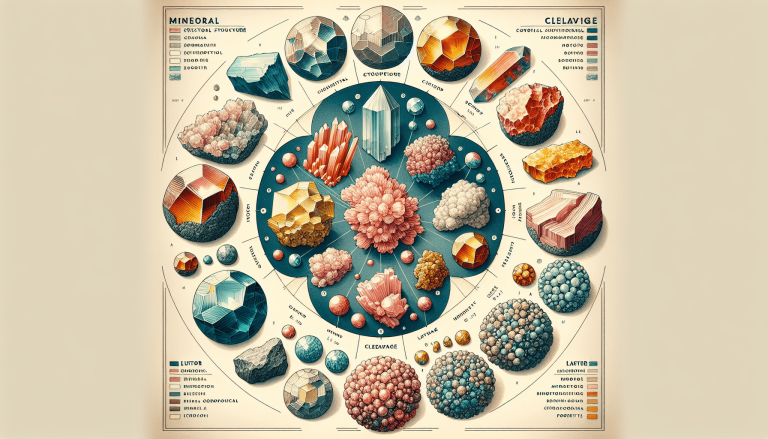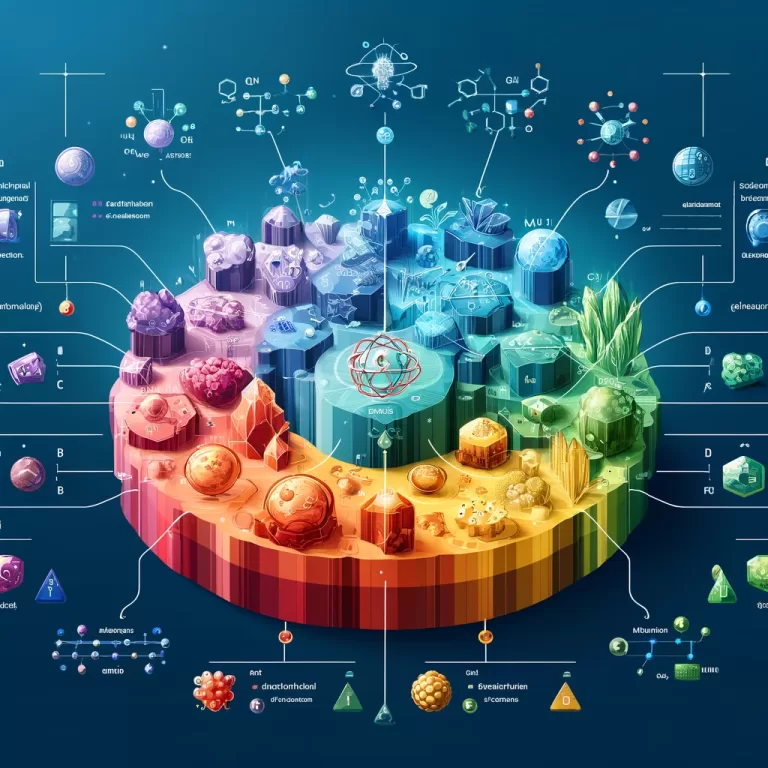Best Ways To Study The Chemical Properties Of Minerals
So you’ve got a passion for minerals and you’re eager to dive into the world of studying their chemical properties? Well, you’ve come to the right place. In this article, we’ll discuss the best ways to delve into the fascinating realm of mineral chemistry. From spectroscopy to electron microscopes, we’ll explore the various techniques that scientists employ to unlock the secrets hidden within these wonders of the Earth. Whether you’re a student, a researcher, or just a curious soul, this guide will provide you with valuable insights on how to study the chemical properties of minerals effectively. So let’s get started!

1. Introduction to Mineral Chemistry
1.1 Definition of mineral chemistry
Mineral chemistry refers to the study of the chemical properties and compositions of minerals. It involves examining the atomic and molecular structures of minerals, as well as the various elements and compounds present in them. By understanding the chemical nature of minerals, scientists can gain valuable insights into their formation, properties, and potential applications.
1.2 Importance of studying the chemical properties of minerals
Studying the chemical properties of minerals is crucial for several reasons. Firstly, it allows scientists to identify and classify minerals based on their composition, helping in the field of mineralogy. This knowledge is essential for geologists and mineralogists as they can use it to determine the origin and formation of minerals, as well as their geological significance.
Furthermore, understanding the chemical properties of minerals is important for various industries such as mining, metallurgy, and geotechnical engineering. It helps in the extraction and processing of minerals, as well as in assessing their economic viability. By studying the chemical properties of minerals, scientists can also discover new minerals or variations of existing ones, which may have industrial applications.
2. Sample Preparation
2.1 Collection of mineral samples
To study the chemical properties of minerals, it is necessary to collect representative samples from various sources such as mines, geological formations, or even meteorites. These samples can be obtained either from surface exposures or by drilling into the earth’s crust. Care must be taken to ensure that the samples are not contaminated and are representative of the mineral of interest.
2.2 Cleaning and grinding the samples
Once collected, the mineral samples need to be cleaned to remove any external impurities or contaminants such as dirt, dust, or organic matter. This is usually done using techniques like washing with water or solvents, followed by drying. Grinding the samples into fine powder is often necessary to ensure homogeneity and facilitate analysis.
2.3 Preparation of thin sections
In some cases, it is beneficial to prepare thin sections of mineral samples. This involves cutting a small slice from the sample, which is then mounted on a glass slide and ground to a thickness of 30 micrometers or less. Thin sections are particularly useful for studying the optical properties of minerals under a microscope.
3. Spectroscopic Techniques
3.1 X-ray Diffraction (XRD)
X-ray diffraction is a widely used technique for determining the crystal structure of minerals. By shining a beam of X-rays onto a mineral sample, the resulting diffraction pattern can provide information about the arrangement of atoms in the crystal lattice. This can be used to identify the mineral and determine its crystal structure, which in turn gives insights into its chemical properties.
3.2 Fourier-Transform Infrared Spectroscopy (FTIR)
FTIR spectroscopy measures the absorption of infrared light by a mineral sample. Different minerals have unique patterns of absorption, allowing scientists to identify and characterize them based on their infrared spectra. FTIR can provide information about the functional groups present in minerals, helping to determine their chemical composition and bonding.
3.3 Raman Spectroscopy
Raman spectroscopy involves the analysis of the scattered light from a mineral sample when illuminated by a laser. By studying the energy shifts and intensities of scattered light, Raman spectroscopy can provide insights into the vibrational modes of mineral compounds. This technique can be used to identify minerals and study their chemical composition, as different mineral compounds exhibit unique Raman spectra.
3.4 UV-Visible Spectroscopy
UV-Visible spectroscopy involves the measurement of the absorption or transmission of ultraviolet and visible light by a mineral sample. This technique can provide information about the electronic properties of minerals, such as the presence of transition metal ions or the nature of their bonding. UV-Visible spectroscopy is useful for analyzing the color and optical properties of minerals.
3.5 Nuclear Magnetic Resonance (NMR)
NMR spectroscopy is a powerful technique for studying the atomic and molecular structure of minerals. It exploits the magnetic properties of certain atomic nuclei, such as hydrogen or carbon, to provide information about their chemical environment and connectivity. NMR can be used to determine the composition and structural arrangement of minerals, as well as investigate their surface properties.
4. Microscopic Techniques
4.1 Optical Microscopy
Optical microscopy involves the use of visible light to examine mineral samples at high magnifications. It allows scientists to observe the mineral’s physical characteristics, such as color, shape, and texture. Polarized light microscopy is particularly useful for studying the optical properties of minerals, such as birefringence, which can provide information about their crystal structure and composition.
4.2 Scanning Electron Microscopy (SEM)
SEM involves scanning a mineral sample with a focused beam of electrons to create a detailed image of its surface morphology. SEM can provide high-resolution images, allowing scientists to study the mineral’s texture, topography, and elemental composition. Energy-dispersive X-ray spectroscopy (EDS) can be coupled with SEM to analyze the elemental composition of specific areas within the mineral sample.
4.3 Transmission Electron Microscopy (TEM)
TEM is a powerful technique for studying the internal structure and composition of minerals at the atomic scale. A thin section of the mineral sample is bombarded with a beam of electrons, and images are formed by the interaction between the electrons and the sample. TEM can provide detailed information about crystal defects, atomic ordering, and even the presence of nanoscale features in minerals.
4.4 Electron Probe Microanalysis (EPMA)
EPMA is a technique that combines electron microscopy with X-ray spectroscopy to analyze the elemental composition of minerals. By directing a focused beam of electrons onto a mineral sample, characteristic X-rays are emitted, which can be detected and used to identify and quantify the elements present. EPMA can provide detailed information about the major and trace element composition of minerals.

5. Chemical Analysis Techniques
5.1 Flame Atomic Absorption Spectrometry (FAAS)
FAAS is a widely used technique for determining the concentration of specific elements in a mineral sample. It involves vaporizing the sample and passing the resulting vapor through a flame, which causes the atoms to emit light at characteristic wavelengths. By measuring the intensity of this emitted light, the concentration of the element in the sample can be determined.
5.2 Inductively Coupled Plasma-Mass Spectrometry (ICP-MS)
ICP-MS is a highly sensitive technique for elemental analysis in minerals. It involves ionizing the sample in an inductively coupled plasma and then analyzing the resulting ions using mass spectrometry. ICP-MS can provide accurate and precise measurements of trace elements in minerals, making it valuable for geochemical and environmental studies.
5.3 Energy-Dispersive X-ray Spectroscopy (EDS)
EDS is a technique that can be used in conjunction with electron microscopy to analyze the elemental composition of minerals. By bombarding the mineral sample with a beam of electrons, X-rays are emitted, and their energies are measured. This allows for the identification and quantification of the elements present in the sample.
5.4 X-ray Fluorescence Spectrometry (XRF)
XRF is a non-destructive technique for elemental analysis of minerals. It involves bombarding the sample with X-rays, causing the atoms to emit characteristic fluorescent X-rays. By analyzing the energies of these X-rays, the elemental composition of the mineral can be determined. XRF is particularly useful for analyzing the major and trace element composition of bulk samples.
5.5 Ion Chromatography (IC)
Ion chromatography is a technique used to separate and analyze ions in a mineral sample. It involves passing a solution containing the sample through a chromatographic column, where the ions are retained based on their charge and affinity to the column material. Different types of detectors can be used to identify and quantify the separated ions, providing information about the mineral’s ionic composition.
6. Thermal Analysis Techniques
6.1 Differential Scanning Calorimetry (DSC)
DSC is a technique used to study the thermal properties of minerals. It measures the heat flow into or out of a sample as a function of temperature. DSC can provide information about phase transitions, melting points, and reactions occurring within the mineral sample. It is particularly useful for studying the thermal stability and behavior of minerals under different conditions.
6.2 Thermogravimetric Analysis (TGA)
TGA is a technique used to determine the weight loss or gain of a mineral sample as a function of temperature. By heating the sample in a controlled environment, any changes in mass due to processes such as dehydration, oxidation, or decomposition can be monitored. TGA can provide information about the thermal stability and composition of minerals, as well as the presence of volatile or hydrated components.
6.3 Differential Thermal Analysis (DTA)
DTA is a technique used to study the phase transitions and reactions occurring in minerals. It involves measuring the temperature difference between a mineral sample and an inert reference material as both are heated or cooled simultaneously. By analyzing the changes in temperature, DTA can provide information about the energy changes associated with phase transitions and reactions in minerals.
7. Crystallography
7.1 Single Crystal X-ray Diffraction
Single crystal X-ray diffraction is a technique used to determine the three-dimensional arrangement of atoms in a mineral crystal. By analyzing the diffraction patterns produced when X-rays pass through a single crystal, scientists can determine the crystal structure and the positions of individual atoms. This information is crucial for fully understanding the chemical properties of minerals.
7.2 Powder X-ray Diffraction
Powder X-ray diffraction is a technique used to analyze the crystal structure of minerals when a single crystal is not available. In this method, a powdered sample is exposed to X-rays, and the resulting diffraction pattern is analyzed. Powder X-ray diffraction can be used to identify and characterize minerals based on their unique diffraction patterns, providing insights into their chemical composition and crystal structure.
8. Electron Microscopy Techniques
8.1 Electron Energy Loss Spectroscopy (EELS)
EELS is a technique used in electron microscopy to determine the chemical composition and electronic properties of materials. By measuring the energy loss of electrons as they pass through a mineral sample, EELS can provide elemental and chemical bonding information. It is particularly useful for studying the distribution and bonding of elements within minerals.
8.2 Electron Backscatter Diffraction (EBSD)
EBSD is a technique used in scanning electron microscopy to analyze the crystallographic orientation and microstructure of minerals. By directing an electron beam onto the mineral surface and measuring the backscattered electrons, EBSD can provide information about crystallographic orientation, grain size, and texture. This technique is valuable for studying the deformation and mechanical properties of minerals.
9. Computational Methods
9.1 Density Functional Theory (DFT)
Density Functional Theory is a computational method used to study the electronic structure and properties of minerals. It involves solving the Schrödinger equation using powerful algorithms and approximations. DFT can provide insights into the energy levels, electronic properties, and reactivity of minerals, helping to understand their chemical behavior and stability.
9.2 Molecular Dynamics (MD) Simulations
MD simulations are computational methods used to study the behavior and dynamics of atoms and molecules in minerals. By simulating the interactions between individual particles over time, MD simulations can provide information about the structure, thermodynamics, and transport properties of minerals. This technique is particularly useful for understanding the behavior of minerals under different conditions and in complex environments.
10. Case Studies
10.1 Analysis of mineral composition and structure
The study of mineral composition and structure is crucial for understanding their properties and potential applications. By employing various spectroscopic, microscopic, and chemical analysis techniques, scientists can determine the elemental and molecular composition of minerals, as well as their crystal structure. This knowledge is essential for fields such as geology, materials science, and mineralogy.
10.2 Determination of trace elements in minerals
Trace elements present in minerals can have significant impacts on their properties and behavior. By utilizing techniques such as ICP-MS, EDS, and chemical analysis methods, scientists can accurately determine and quantify trace elements in minerals. This information can provide insights into the formation processes, geological history, and even the environmental impact of minerals.
10.3 Investigation of mineral reactions and transformations
Minerals can undergo various reactions and transformations under different conditions and over geological timescales. By combining different analytical techniques and computational methods, scientists can study the chemical and physical changes occurring in minerals. This knowledge is crucial for understanding geological processes, such as metamorphism, weathering, and even the formation of valuable mineral deposits.
In conclusion, studying the chemical properties of minerals is vital for gaining a comprehensive understanding of their composition, structure, and behavior. The wide range of techniques available, from spectroscopy and microscopy to chemical analysis and computational methods, provides scientists with powerful tools to investigate minerals at different scales and levels of detail. By employing these methods, researchers can unlock valuable insights into the geological, industrial, and environmental significance of minerals.







